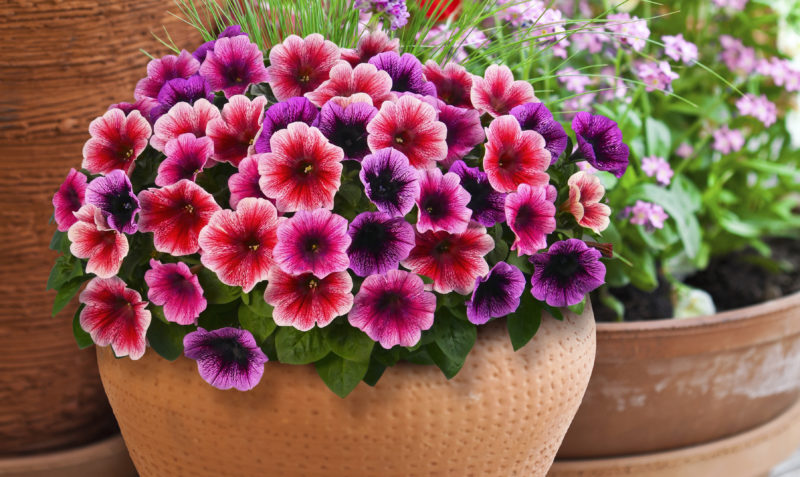
A Passion for Breeding
Petunia and calibrachoa are two of the biggest genera in our industry today. As a flower breeding company, Westhoff has focused on distinguishing itself from their competitors by developing varieties that exceed the diversity that other breeders typically introduce. The Crazytunia series of petunias along with the Candy Shop and Chameleon calibrachoas have set the bar for plant novelty; no other breeder has brought to market a wider palette of colors and selections of flower patterns than Westhoff.
But the question is always: When a breeder is on the cutting edge of variety selection, what comes next? What drives the next wave of innovation? While there are some commonalities with all plant genera that breeders will look for when selecting new varieties, there are also some characteristics — specific to petunia and calibrachoa — that are worth mentioning. And then as a breeding company that focuses on these two genera, we also have a distinct vision for what we hope to bring to growers and the gardening public.
GARDEN PERFORMANCE IS THE END RESULT
Most breeders will agree that all commercial ornamental plant breeding intended for the landscape, regardless of genus and species, must be done with final garden performance in mind. While new selections may be easier to grow or have an amazing new flower pattern, if the end user does not have a positive experience, the variety will be short lived in the market. Breeders go to great lengths to get their selections outside and growing under typical garden conditions — sometimes by building large, private trial gardens and by partnering with large landscape installations or botanical gardens — to gauge what a home gardener could reasonably expect.

“Garden performance” applies to almost all breeding because it is a very general term that encapsulates many factors that are challenging to test individually, and one factor may not be relevant without other factors. For instance, it is not important if the selection is mildew resistant if the flowers do not hold up in a rainy environment since these two factors usually occur together, i.e., rainy conditions can lead to higher rates of mildew. Good garden performance captures both factors without having to select for only one. Other characteristics that would fall into a garden performance selection that are gaining in importance would be enhanced drought tolerance, lower nutrient use/requirements, and self-cleaning.
Focusing more specifically on the breeding priorities for petunias and calibrachoa, our breeders are always on the lookout for novel flower colors and patterns — but since we have several well-established series that focus on this, we are moving to the next phase where we are looking for improvements. A tighter habit, flowering under shorter daylengths and heavier branching are all plant selection criteria we are using, but we are also able to improve on the flowers by selecting higher contrasting bicolors, more intense or saturated colors — and by focusing on selecting colors that are becoming trendy, while not selecting more muted, less captivating colors choices. It is when we are able to combine a great flower color or pattern with an improved plant characteristic that we really feel we are moving our breeding, and the plant class as a whole, forward.
THE FUTURE OF PETUNIA AND CALIBRACHOA
Even with these similarities in priorities, petunias and calibrachoa do differ in a few ways. The most significant, for Westhoff, is that petunias have been actively bred and improved for a longer time. This longer timeframe has led to ample opportunities to try new crosses and discover patterns and colors that did not exist before. It can be seen with calibrachoa that every time a new pattern is introduced, usually a similar pattern has been found in petunias before. Since they are closely related, this is not very surprising, but with the continued rise in popularity of calibrachoa over petunia, we will likely see more of these classic petunia patterns showing up in the newest calibrachoa breeding.

Plant breeding companies are currently in the midst of a renaissance in breeding, developing and bringing to market novel plant varieties — and we are still only seeing the very tip of the iceberg of what is possible. But simply because we are currently all benefiting from this wave of diversity, there are some concerning clouds on the horizon. The continued consolidation of plant breeding companies may in the long run reduce the healthy competition that helps drive innovation, and new legal protections coming into more common use may end up restricting the pool of high-quality genetics that has historically allowed for the free exchange of beneficial traits.
The plant breeding industry has always built upon the successes and innovations that we individually achieve to eventually improve the quality of products available to the gardening public. And although we must always protect the breeder’s rights to be fairly compensated for their hard work, limiting the free flow of genetics will only lead to reduced innovation, and eventual stagnation, of the driving engine of the ornamental greenhouse industry.
But despite these challenges, I think that the outlook for the future of ornamental plant breeding is very bright. It is entertaining to discuss the potential new developments that are coming — but because we have so much more to discover, it is the unknown advances and the chance for finding something completely new, cultivating that novelty and bringing it to market that are the most exciting. With every new batch of seedlings is the chance to move forward and share some of our passion for flowers with growers and gardeners around the world


 Video Library
Video Library 




















